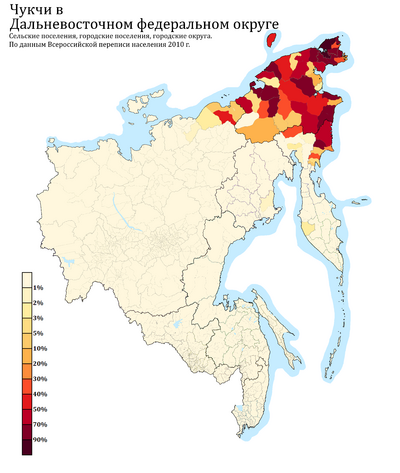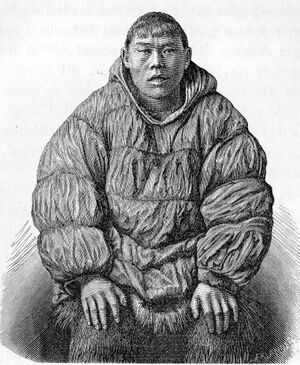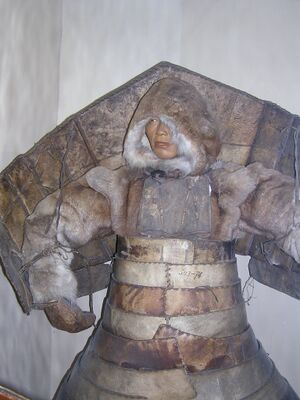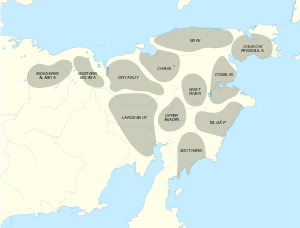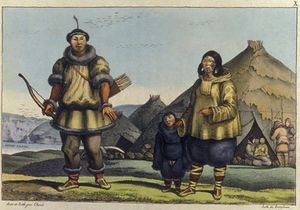تشوكتشي (شعب)
Luoravetlan | |
|---|---|
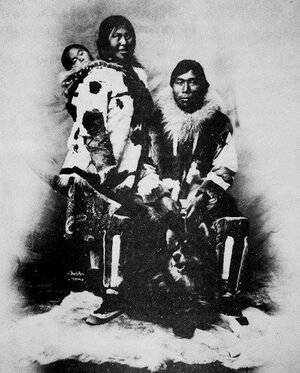 Chukchi family and their Siberian Husky, early 20th century | |
| إجمالي التعداد | |
| 16,241 | |
| المناطق ذات التجمعات المعتبرة | |
| 16,200[1] | |
| | 13,292[1] |
| 30[2] | |
| 11[3] | |
| اللغات | |
| الروسية، التشوكتشي | |
| الدين | |
| الشامانية، الأرثوذكسية الروسية | |
| الجماعات العرقية ذات الصلة | |
| other Chukotko-Kamchatkan peoples | |
التشوكتشي Chukchi أو Chukchee (قالب:Lang-ckt؛ Ḷygʺoravètḷʹèt, O'ravètḷʹèt)، هم شعب أصلي سيبيري موطنه شبه جزيرة تشوكتشي وسواحل بحر تشوكتشي ومنطقة بحر بيرنج من المحيط القطبي الشمالي[4] وكلهم ضمن روسيا الحديثة. ويتكلمون لغة التشوكتشي. وينحدر التشوكتشي من شعب عاش حول بحر أخوتسك. حسب العديد من الدراسات الجينومية التي أُجريت من 2014 إلى 2018، التشوكتشي هم أحد الشعوب الأصلية في سيبيريا. كما أنهم أقرب الآسيويين إلى الشعوب الأصلية في الأمريكتين وكذلك الأقرب لشعب الآينو وشعوب شرق آسيا الأخرى، لكونهم سليلي مستوطنين لم يعبروا مضيق بيرنج ولم يستوطنوا الأرخبيل الياباني.[5][6]
التاريخ الثقافي
The majority of Chukchi reside within Chukotka Autonomous Okrug, but some also reside in the neighboring Sakha Republic to the west, Magadan Oblast to the southwest, and Kamchatka Krai to the south. Some Chukchi also reside in other parts of Russia, as well as in Europe and North America. The total number of Chukchi in the world slightly exceeds 16,000.
The Chukchi are traditionally divided into the Maritime Chukchi, who had settled homes on the coast and lived primarily from sea mammal hunting, and the Reindeer Chukchi, who lived as nomads in the inland tundra region, migrating seasonally with their herds of reindeer. The Russian name "Chukchi" is derived from the Chukchi word Chauchu ("rich in reindeer"), which was used by the 'Reindeer Chukchi' to distinguish themselves from the 'Maritime Chukchi,' called Anqallyt ("the sea people"). Their name for a member of the Chukchi ethnic group as a whole is Luoravetlan (literally 'genuine person').
In Chukchi religion, every object, whether animate or inanimate, is assigned a spirit. This spirit can be either harmful or benevolent. Some of Chukchi myths reveal a dualistic cosmology.[7][8]
After the collapse of the Soviet Union, the state-run farms were reorganized and nominally privatized. This process was ultimately destructive to the village-based economy in Chukotka. The region has still not fully recovered. Many rural Chukchi, as well as Russians in Chukotka's villages, have survived in recent years[when?] only with the help of direct humanitarian aid. Some Chukchi have attained university degrees, becoming poets, writers, politicians, teachers and doctors.[بحاجة لمصدر]
الإعاشة
In prehistoric times, the Chukchi engaged in nomadic hunter gatherer modes of existence. In current times, there continue to be some elements of subsistence hunting, including that of polar bears,[9] seals, walruses, whales, and reindeer. However, there are some differences between the traditional lifestyles of the coastal and inland Chukchi. The former (coastal Chukchi) were largely settled fishers and hunters (mainly of sea mammals). The inland Chukchi were partial reindeer herders.[10]
Beginning in the 1920s, the Soviets organized the economic activities of both coastal and inland Chukchi and eventually established 28 collectively run, state-owned enterprises in Chukotka. All of these were based on reindeer herding, with the addition of sea mammal hunting and walrus ivory carving in the coastal areas. Chukchi were educated in Soviet schools and today are almost 100% literate and fluent in the Russian language. Only a portion of them today work directly in reindeer herding or sea mammal hunting, and continue to live a nomadic lifestyle in yaranga tents.[11]
العلاقة بالروس
Russians first began contacting the Chukchi when they reached the Kolyma River (1643) and the Anadyr River (1649).[12] The route from Nizhnekolymsk to the fort at Anadyrsk along the southwest of the main Chukchi area became a major trade route. The overland journey from Yakutsk to Anadyrsk took about six months.
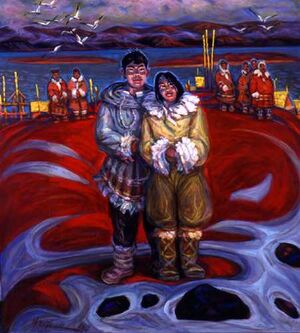
The Chukchi were generally ignored for the next fifty years because they were warlike and did not provide furs or other valuable commodities to tax. Armed skirmishes flared up around 1700 when the Russians began operating in the Kamchatka Peninsula and needed to protect their communications from the Chukchi and Koryak. The first attempt to conquer them was made in 1701. Other expeditions were sent out in 1708, 1709 and 1711 with considerable bloodshed but little success and unable to eliminate the local population on the large territory. War was renewed in 1729, when the Chukchi defeated an expedition from Okhotsk and killed its commander. Command passed to Major Dmitry Pavlutsky, who adopted very destructive tactics, burning, killing, driving off reindeer, and capturing and killing women and children.[13] In 1742, the government at Saint Petersburg ordered another war in which the Chukchi and Koryak were to be "totally extirpated". The war (1744–7) was conducted with similar brutality and ended when Pavlutsky was killed in March 1747.[13] It is said that the Chukchi kept his head as a trophy for a number of years. The Russians waged war again in the 1750s, but a part of Chukchi people did survive this extermination plans on the very far North East (see on the right a map for population territories during the extermination activity by Russian empire).
In 1762 with a new ruler, Saint Petersburg adopted a different policy. Maintaining the fort at Anadyrsk had cost some 1,380,000 rubles, but the area had returned only 29,150 rubles in taxes, so the government abandoned Anadyrsk in 1764. The Chukchi, no longer attacked by the Russian Empire, began to trade peacefully with the Russians. From 1788, they participated in an annual trade fair on the lower Kolyma. Another was established in 1775 on the Angarka, a tributary of the Bolshoy Anyuy River. This trade declined in the late 19th century when American whalers and others began landing goods on the coast. The first Orthodox missionaries entered Chukchi territory some time after 1815. And the strategy worked. Trade began to flourish between the Cossacks and the Chukchi. with annual trade fairs, where goods were exchanged, were set up and the two peoples were finally speaking the same language. The natives, however, never paid yasak, and their status as subjects was little more than a formality. The formal annexation of the Chukotka Peninsula did not happen until much later, during the time of the Soviet Union.[14]
الفترة السوڤيتية
Apart from four Orthodox schools, there were no schools in the Chukchi land until the late 1920s. In 1926, there were 72 literate Chukchis. The Soviets introduced a Latin alphabet in 1932, replacing it with Cyrillic in 1937. In 1934, 71% of the Chukchis were nomadic. In 1941, 90% of the reindeer were still privately owned. So-called kulaks roamed with their private herds up into the 1950s. After 1990 and the fall of the Soviet Union, there was a major exodus of Russians from the area because of underfunding the local industry.
Population estimates from Forsyth:
- 1700: 6,000
- 1800: 8,000–9,000
- 1926: 13,100
- 1930s: 12,000
- 1939: 13,900
- 1959: 11,700
- 1979: at least 13,169
نكات حولهم
Chukchi jokes are a form of ethnic humor. They are portrayed as primitive yet clever in a naive way.[15][16]
المراجع
- ^ أ ب "Национальный состав населения". Federal State Statistics Service. Retrieved 30 December 2022.
- ^ State statistics committee of Ukraine – National composition of population, 2001 census. Ukrainian Federal State Statistic Service
- ^ RL0428: Rahvastik rahvuse, soo ja elukoha järgi, 31. detsember 2011. Statistics Estonia
- ^
 Chisholm, Hugh, ed. (1911). . دائرة المعارف البريطانية. Vol. 6 (eleventh ed.). Cambridge University Press. p. 323.
Chisholm, Hugh, ed. (1911). . دائرة المعارف البريطانية. Vol. 6 (eleventh ed.). Cambridge University Press. p. 323. {{cite encyclopedia}}: Cite has empty unknown parameter:|coauthors=(help) - ^ Reich, David (2018). Who We Are and How We Got Here: Ancient DNA and the New Science of the Human Past. New York: Pantheon Books.
- ^ Kura, Kenya; Armstrong, Elijah L.; Templer, Donald I. (2014-05-01). "Cognitive function among the Ainu people". Intelligence (in الإنجليزية). 44: 149–154. doi:10.1016/j.intell.2014.04.001. ISSN 0160-2896.
- ^ Zolotarjov, A.M. (1980). "Társadalomszervezet és dualisztikus teremtésmítoszok Szibériában". In Hoppál, Mihály (ed.). A Tejút fiai. Tanulmányok a finnugor népek hitvilágáról (in الهنغارية). Budapest: Európa Könyvkiadó. pp. 40–41. ISBN 963-07-2187-2. Chapter means: "Social structure and dualistic creation myths in Siberia"; title means: "The sons of Milky Way. Studies on the belief systems of Finno-Ugric peoples".
- ^ Anyiszimov, A. F. (1981). Az ősközösségi társadalom szellemi élete (in الهنغارية). Budapest: Kossuth Könyvkiadó. pp. 92–98. ISBN 963-09-1843-9. Title means: "The spiritual life of primitive society". The book is composed out of the translations of the following two originals: Анисимов, Ф. А. (1966). Духовная жизнь первобытново общества (in الروسية). Москва • Ленинград: Наука. The other one: Анисимов, Ф. А. (1971). Исторические особенности первобытново мышления (in الروسية). Москва • Ленинград: Наука.
- ^ Hogan, C. Michael (2008) Polar Bear: Ursus maritimus, Globaltwitcher.com, ed. Nicklas Stromberg
- ^ Winston, Robert, ed. (2004). Human: The Definitive Visual Guide. New York: Dorling Kindersley. p. 429. ISBN 0-7566-0520-2.
- ^ "Amazing Life of Chukchi". English Russia. Archived from the original on 12 April 2011. Retrieved 7 May 2011.
- ^ Forsyth, James (1992) A History of the Peoples of Siberia, for this and the next section
- ^ أ ب Shentalinskaia, Tatiana (Spring 2002). "Major Pavlutskii: From History to Folklore" (PDF). Slavic and East European Folklore Association Journal. 7 (1): 3–21. Archived from the original (PDF) on 17 July 2011. Retrieved 2009-07-18.
- ^ Zhukov, Pavel (2020-06-16). "Russia's bloody struggle against the terrifying Chukchi aboriginals". www.rbth.com (in الإنجليزية الأمريكية). Retrieved 2021-06-09.
- ^ "Gendai Sobieto shakai no minshuu-denshoo to shite no Chukuchi-jooku."("Chukchee jokes as a form of modern Soviet folklore", transl. by Hiroshi Shoji). – Kotoba-asobi no minzokushi. Ed. by EGuchi Kazuhisa. Tokyo 1990, 377–385
- ^ Бурыкин А.А., Анекдоты о чукчах как социокультурное явление in: Анекдот как феномен культуры. Материалы круглого стола 16 ноября 2002 г. СПб.: Санкт-Петербургское философское общество, 2002. С.64–70(retrieved March 10, 2015)
للاستزادة
- Patty A. Gray (2005). The Predicament of Chukotka's Indigenous Movement: Post-Soviet Activism in the Russian Far North. Cambridge. ISBN 0-521-82346-3.
- Anna Kerttula (2000). Antler on the Sea. Cornell University Press. ISBN 0-8014-3681-8.
- "The Chukchis". The Red Book of the Peoples of the Russian Empire.
- "All Things Arctic". Archived from the original on 15 May 2013.
- Ĉukĉ, Even, Jukaghir. Kolyma: Chants de nature et d'animaux. Sibérie 3. Musique du monde.
وصلات خارجية
- Bogoraz, Waldemar (1904). The Chukchee. Vol. 11 Part 1: Material culture (PDF). Memoirs of the American Museum of Natural History. Leiden • New York: E. J. Brill ltd • G. E. Stechert & Co.
- Bogoraz, Waldemar (1907). The Chukchee. Vol. 11 Part 2: Religion (PDF). Memoirs of the American Museum of Natural History. Leiden • New York: E. J. Brill ltd • G. E. Stechert & Co.
- Bogoraz, Waldemar (1909). The Chukchee. Vol. 11 Part 3: Social organization (PDF). Memoirs of the American Museum of Natural History. Leiden • New York: E. J. Brill ltd • G. E. Stechert & Co.
- Bogoraz, Waldemar (1910). Chukchee Mythology (PDF). Memoirs of the American Museum of Natural History. Leiden • New York: E. J. Brill ltd • G. E. Stechert & Co.
- Siimets, Ülo (2006). "The Sun, the Moon and Firmament in Chukchi Mythology and on the Relations of Celestial Bodies and Sacrifices" (PDF). Electronic Journal of Folklore. Estonian Folklore. 32: 129–156. doi:10.7592/fejf2006.32.siimets.
- مقالات المعرفة المحتوية على معلومات من دائرة المعارف البريطانية طبعة 1911
- CS1 الهنغارية-language sources (hu)
- CS1 uses الروسية-language script (ru)
- CS1 الروسية-language sources (ru)
- CS1 الإنجليزية الأمريكية-language sources (en-us)
- Articles with hatnote templates targeting a nonexistent page
- Missing redirects
- Short description is different from Wikidata
- Articles using infobox ethnic group with image parameters
- Vague or ambiguous time from April 2023
- Articles with unsourced statements from April 2023
- شعب تشوكتشي
- Indigenous peoples in the Arctic
- إسكيمو
- جماعات عرقية في روسيا
- جماعات عرقية في سيبيريا
- Indigenous peoples of North Asia
- Indigenous small-numbered peoples of the North, Siberia and the Far East
- Modern nomads
- جماعات بدوية في أوراسيا
- أشخاص من أكروج تشوكتكا الذاتي
- بحر بيرنج
- بحر تشوكتشي
- أكروج تشوكتكا الذاتي
